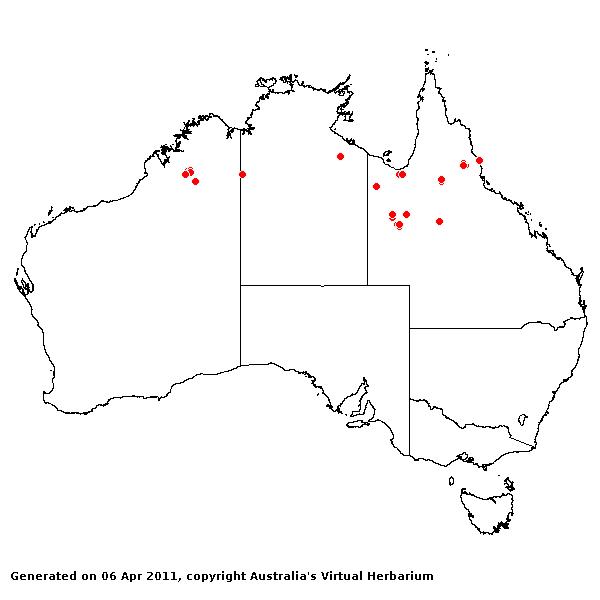Aristida polyclados Domin. Biblioth.
Bot. 85: 338 (1915).
Classification. (GPWG 2001) : Subfamily Aristidoideae. Aristideae.
Type of Basionym or
Protologue Information: HT: K. Domin s.n., Feb 1910, Australia:
Nord-Queensland: Cook Dist.: bei Chillagoe (L (photo, BRI); IT: BRI).
Key references
(books and floras): [2002] D.Sharp & B.K.Simon, AusGrass, Grasses of
Australia.
Illustrations:
[1983] J.C.Tothill & J.B.Hacker, Grasses of Southern
Queensland (104(7)).
Derivation: Gk.
polys, several; klados, branch. Plants with much branched culms
often with the branches in fascicles.
Habit. Annual.
Culms geniculately ascending, 29–40 cm tall. Mid-culm internodes glabrous.
Lateral branches branched. Leaf-sheaths scaberulous, glabrous on surface or
hairy. Ligule a fringe of hairs, 0.5 mm long. Leaf-blades straight, filiform,
flat or conduplicate or involute or convolute, 8–11 cm long, 0.5–1.8 mm wide.
Leaf-blade surface scabrous, indumented.
Inflorescence.
Inflorescence compound, a panicle. Panicle elliptic, 7–19 cm long, 8 cm wide.
Spikelets.
Spikelets pedicelled. Fertile spikelets 1-flowered, comprising 1 fertile
floret(s), without rachilla extension, lanceolate, terete, 17–30 mm long.
Glumes.
Glumes similar, thinner than fertile lemma. Lower glume lanceolate, membranous,
keeled, 1-keeled, 1 -nerved. Lower glume surface glabrous or indumented. Lower
glume apex awned. Upper glume lanceolate, 13–20 mm long, membranous, keeled,
1-keeled, 1 -nerved. Upper glume surface glabrous or indumented. Upper glume
apex entire, awned.
Florets.
Fertile lemma 7–8 mm long, without keel, 3 -nerved. Lemma apex awned, 3 -awned.
Median (principal) awn 47–111 mm long overall, with a twisted column. Column
15–35 mm long. Lateral lemma awns present. Palea without keels. Anthers 3.
Grain 3.7–5.6 mm long.
Continental
Distribution: Australasia.
Australian
Distribution: Western Australia, Northern Territory, Queensland.
Western Australia: Gardner, Dampier. Northern Territory:
Darwin & Gulf. Queensland:
Burke, Cook, Gregory North.
Notes.
A.polyclados differs from other species of section Arthratherum
by having inverse glumes.
One
record from the Kimberly region, Western Australia,
one record from the "top end" of the Northern
Territory, but mainly recorded from a few tropical dry areas of Queensland. It also
occurs on Soemba Island, Indonesia. Eucalyptus
woodlands on sandy soils and alluvial sites. Flowering and fruiting January to
March, May to July.



